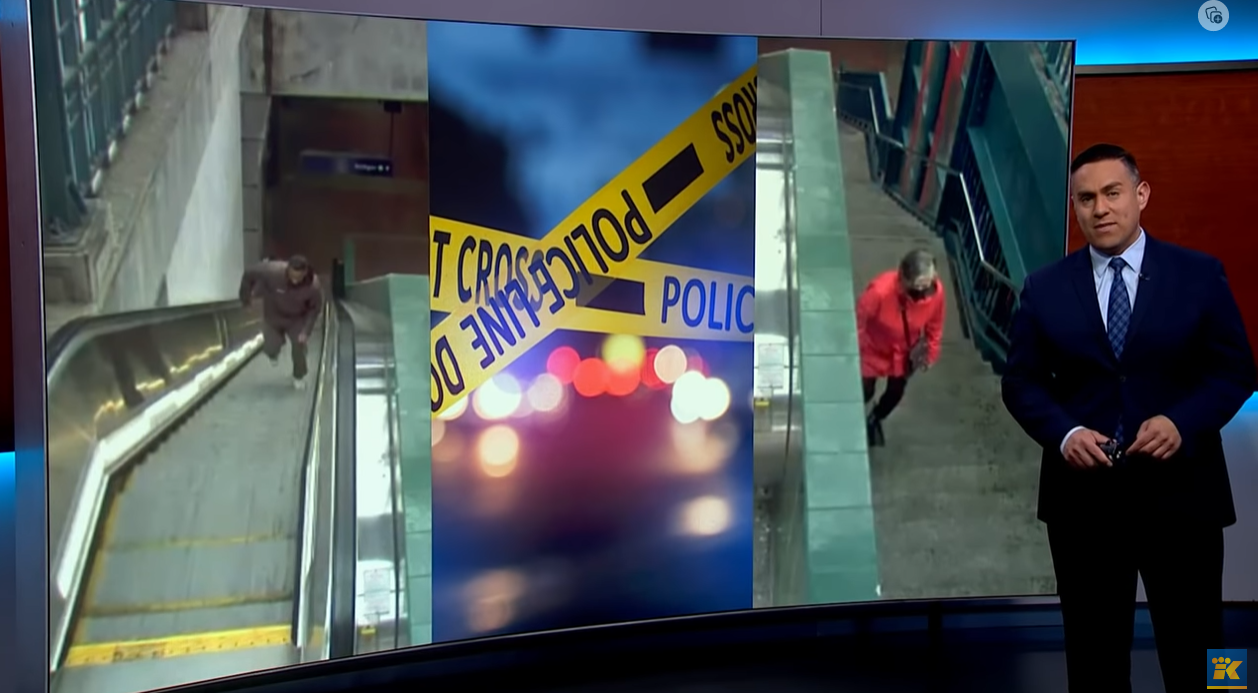Crime is a legitimate topic for news coverage because of concerns about the public’s safety. KING’s mission in Seattle is to “cover crime in a way that helps them be informed and empowered in ways that make sense,” says News Director Julie Wolfe.
Covering crime is often the low-hanging fruit for local TV news operations. Police scanners in TV newsrooms alert the stations there’s been a crime. Reporters and photojournalists rush to the scene.
Police tape, flashing police car lights and officials working the crime scene makes for exciting footage. In TV news speak, it’s sexy video.
Then after the crime, there’s the arrest, the perp walk, the mugshot, the suspect’s name and criminal history. All play out for thousands of news viewers to see every night. Over time, it can have a toxic effect on our perception.
Crime has been the stuff that’s driven local TV news from the beginning.

“It’s just the business, that’s the way the business was organized,” says Dr. Dan Romer, Annenberg Public Policy research director, in a Philadelphia Inquirer article in March 2022. “It was a way to generate viewers.”
Crime is a legitimate topic for news coverage because TV stations have an obligation to look after the public’s safety.

“Safety is really important to people, people’s personal safety, the safety of their family, the safety of their home, their business, their city, that’s really important,” says Julie Wolfe, the news director at KING, Tegna’s NBC affiliate in Seattle.
Wolfe says since people care so much about their safety, KING’s mission is to “cover crime in a way that helps them be informed and empowered in ways that make sense.”

The move away from the “if it bleeds, it leads” mentality toward one of explanatory and accountability reporting is happening in newsrooms across the country, according to an April 2023 article by Kelly McBride, senior vice president and chair of the Craig Newmark Center for Ethics and Leadership at the Poynter Institute, a nonprofit that provides journalism ethics training to journalists.
“Newsrooms are implementing policies designed to encourage deep reporting on public safety trends,” McBride says. “And, they are discouraging common journalism habits that can amplify false stereotypes, like rampant use of police mugshots, or relying on police press releases as the sole source of information for stories.”
Wolfe says KING was having those conversations internally when the station sent some newsroom staff to a workshop held by Poynter last summer.

Christine Pae, an anchor and reporter at KING, attended the workshop.
“We have conversations now about should we even put up a mugshot,” Pae says. “It’s an attitude and a mindset that newsrooms are trying to adopt.”
KING has a written set of guidelines on how to handle what crime it covers, use of names, mugshots and criminal history, mental health, suicide, drunk driving and domestic violence.
KING’s guidelines on whether to use a mug shot and name the suspect depend on whether the suspect has been charged and if the station has committed to following the story, Wolfe says.
“On big stories, like we cover all the time, if someone is charged, then we use those mugshots,” Wolfe says. “We do say in our scripts, we are not showing the mug hot or naming this person because they haven’t been charged,” Wolfe says. “We are really transparent about it.”
Wolfe says “this is one story where we edited this video because of its level of violence.”
Based on how KING handled the story, the victim gave the station an exclusive interview, Wolfe says.
Wolfe says the newsroom is always trying to find that balance between how the crime impacts the community and making sure the station lives up to its ethics.
Historically, decades of crime coverage have done harm to the community, especially in the Black community, Wolfe says.
It’s a sentiment backed up through the years by watchdog organizations, scholars and institutes of higher learning.
An article from November of 2003 by the University of Nebraska in Omaha, titled Race and Local Television News Crime Coverage, says, “When an African-American suspect was shown in police custody, the images tended to reinforce existing racial stereotypes about African Americans as dangerous criminals.”
The National Press Foundation in an article from February 2023, says “The ‘if it bleeds, it leads’ coverage … has also been criticized for deepening racial stereotypes.”
In another article by two university professors, Franklin D. Gilliam, Jr. at the University of California at Los Angeles, and Shanto Iyengar at Stanford, from July 2000 says crime coverage dominates local TV news.
“The prevalence of this type of reporting has led to a crime narrative or ‘script’ that includes two core elements: crime is violent and perpetrators of crime are non-white males … which heightens negative attitudes about African Americans among white viewers,” Gilliam and Iyengar say in the opening paragraph.
“We want to make sure that we humanize what the impact of crime is,” Wolfe says.
KING’s goal is to provide crime news with context. Pae cites a recent story about a shooting as an instance.
“The producers added some crime data that is very easily obtainable from Seattle police department,” Pae says. “That decision itself is adding context to show how common were the shootings.”
Wolfe says if a crime occurs, KING tries to stay on the story, answer why did it occur and was it a result of rising crime in the area.
“That’s what sets KING apart in this market,” Wolfe says.
Wolfe admits changing how crime is covered in local TV news is hard for a newsroom. “You have to have buy in,” Wolfe says. “If you don’t, you quickly slip back into what is low-hanging fruit.”
New Jobs Posted To TVNewsCheck
CLICK HERE to see new jobs posted to TVNewsCheck’s Media Job Center including openings for a general manager, director of engineering, managing editor/director of Now, manager of business operations and a multimedia journalist.
Comments (2)
Reader Interactions
Leave a Reply
You must be logged in to post a comment.
-
-
“And, they are discouraging common journalism habits that can amplify false stereotypes, like rampant use of police mugshots, or relying on police press releases as the sole source of information for stories.”
This is not a journalistic decision, it’s a political decision. Let’s not rely on the police, because what’s really missing from the story is the perp’s point of view, right?
And then they embrace a marketing slogan that says KING “stands for the truth?” It stands for the narrative, not the truth.





KING Is a great station and Seattle viewers respond in kind with their loyalty. I was recently in Seattle for a brief couple of days and was repeatedly stopped for photos, conversations, etc. because KING viewers recognized me from Raw Travel. Anecdotal, I realize, but nothing drives home the connection of a station to the market it serves like these experiences and I can attest, KING is doing some or several things right. I think this article provides a great example for other stations to follow. Long live KING 🙂